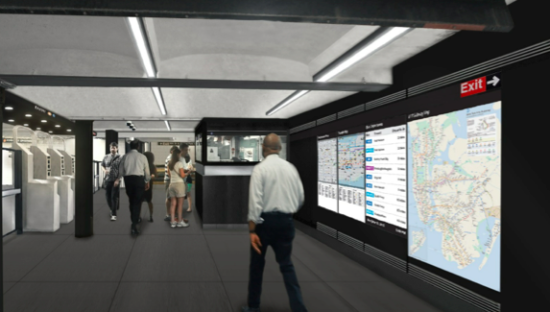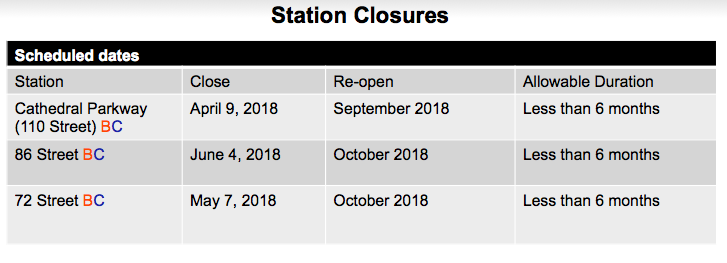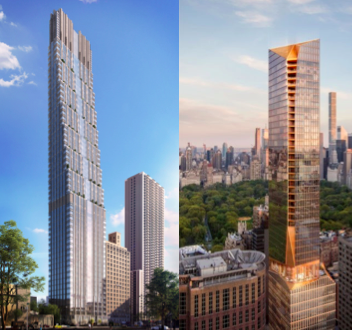
A rendering of the interior of the 86th street station after the upgrades.
The MTA sent us a presentation explaining when the subway stations on the B and C lines at 110th, 86th and 72nd streets are expected to close, and gave more detail on what each station will receive.
Here are the dates of the expected closures:
As to the inconvenience caused by the closures, a rep sent a statement explaining why they were doing it this way.
“This is a program that allows us to do essential work to preserve these stations for the next generation,” the MTA rep wrote. “This will allow us to get in and get out, doing work more quickly over the course of months instead of years.”
Local officials have criticized the plan and the lack of more specific mitigation efforts as more than 30,000 passengers use those stations on a daily basis. The entire plan, which also includes info about renovations at 163rd street, is below:
ESI Package 3 020518 Draft 110 86 72 by westsiderag on Scribd









Clowns!
Too much money for cosmetics! Where are the elevators?
lipstick
…on a pig
Absolutely, lipstick on a pig. It’s like the great minds of the MTA chuck random sh@t at a wall and hope something–ANYthing–sticks. We need elevators before everything else. Yes, it may be structurally very complex to make this happen. That said, most people who dismiss elevators as impossible are not the ones who NEED elevators. It never fails to amaze me that the MTA gets away with having such an inaccessible system. I don’t want a latte bar in the platform (OK, I actually do), I want to be able to GET to the platform when I’m injured or pushing a stroller.
Nadine,
Your frustration is completely understandable. I have a friend who is a wheel chair user and she suffers greatly using the NYC subway. More than once have we had to pick her up because Access-a-ride has left her stranded in the middle of town with no options.
However, and it is unfortunate but a reality, a lot of stations simply cannot have an elevator installed without major infrastructure work and subsequently huge service gaps which would be considered unacceptable. We’re dealing with a system that was built many decades ago before ADA was even on the horizon. Provisions for elevators were never considered and now were stuck. Either way, damned if you do or damned if you don’t.
I didn’t see the last webcast so I can’t comment beyond the document posted here and prior experience.
I hope Mr. Byford has a positive impact on the subway, I truly do. As far as the board is concerned I don’t place much trust on them. From what I’ve seen they’re a disjointed group of quasi politicians with personal and competing agendas.
But if we really want to see the subway improve as New Yorkers deserve, the finger and most of the criticism has to be directed towards Albany. All this “lip stick-on-the-pig projects as some people call it, are coming from the top. Oh, and it would help tons if the labor unions were reigned back a few notches. There are too many absurd union rules that cost the MTA insane amounts of money.
Thing is, the ADA basically requires that when major renovations are done on transit stations, they be made accessible. I’m not sure how they’re getting away with not doing that here.
I think if this came from the MTA – we studied elevator access, here are the main hurdles and here are the projected costs, should we install them, yes or no – that would be a lot different. I don’t feel like that’s been the approach here.
The way I interpreted the board meeting yesterday was that Andy Byford and the board are going to start to shift the MTA’s approach from the attitude that we’ve been seeing.
As it is I feel like we might as well just set $75 million on fire and pay $8 million for LED screens outside the stations.
Hi Margaret,
Six month closure and $83M may not be enough because of other restrictions. Kindly, refer to my response to DR below.
My point is that it’s not always the money the issue.
Zulu, I think people obviously get that installing an elevator is a large project. The question is, why isn’t a six-month full closure and $83 million dollars enough to get it done. Like I said above, nobody is asking for this to be effortless or free. We are already spending a truckload of money and hugely inconveniencing thousands of people. The elevators are sorely needed in this neighborhood and the law has been in effect for 28 years.
Wrong, water leaks is the main cause of premature deterioration for underground structures.
Underground water is a relentless force that can only be managed and never truly be solved. Waterproofing is the very first thing you have to do before any other work is done. So, no it’s not lipstick on a pig, it’s THE pig.
Waterproofing, floor toppings and spall repairs are not cosmetics.
I don’t know about these particular stations but for a lot of the elevators are not possible due obstructions above ground or conflict with building foundations. Other times the elevator would end up in the middle of a roadway. Things to consider before casting blanket statements.
The failure to make every subway station ADA accessible is unacceptable and an insult to the 50+ million Americans with disabilities. Don’t be so fast to discount us. We deserve to have our rights acknowledged and honored! We are the largest minority group in America and the only one that anyone can unwittingly join at any time!
At six months of closure for three stations at $83 million, the public expenditure for each of these closed stations is going to be $150,000 per day.
I don’t follow why relocating utilities is seen as impossible for $27,666,667 each. Nobody is asking for it for free or even for cheap. We are paying astronomical amounts of money. Elevators are preferable to LED lighting, in terms of NYC productivity and the subway’s capacity. And Joe Lhota isn’t writing an $83 million check out of the goodness of his heart, these are public funds.
I didn’t say it was only the relocation of utilities that make installing elevators impossible. That is only one issue an elevator project has to contend with. The main obstacle is the space which in most cases is extremely limited to non existent.
Are they not providing handicapped access?? If not why not?
Are they adding comfy couches for our 20 minute waits for a train?
DON’T FIX THE STATIONS, FIX THE TRAINS!
Where the hell are the elevators!?!?!?!? It’s 2018 – why doesn’t every single station have elevators!?!?!?!
Shari,
A lot of stations are not capable of having elevators. I posted above a brief explanation. A lot of stations are not neatly aligned with the streets above making it difficult to locate an elevator above ground. The challenges include conflict with private property as it would require private building owners to agree to give away space for the elevators to be installed. Other times the foundations of these building get in the way of the elevator and would require massive redesign of a building’s supports.
Most people grossly underestimated how much space is required for an elevator to be installed. People see the finished product and think it’s as easy as 1,2,3 but fail to realize the complexity involved. Some of the issues every elevator project faces:
-utility relocations (ConED)
-private property acquisitions (Lots of legal fees and time that don’t actually go to the construction of the elevator. Only if the private owner agrees, most don’t.)
-conflict with building foundations (more money, again if the private building owner agrees.)
-space limitations (It’s not just for the elevator shaft but also enough space for landings so people can queue at the doors but also have enough room to exit the cab.)
Just because people in hell want ice water does it mean they’re going to get it.
The MTA and the City could collaborate to add an elevator at the southeast exit of the 110th Street station, by the park. There is no building there, and there should be enough space. Currently none of the stations on this line between 59th and 125th are accessible. Waterproofing is important, but should not take this long, and each exit could be worked on sequentially.
Yes, at 110th St. there is plenty of space for an elevator at street level thanks to the plaza where St. Nicholas used to be. But keep in mind it would require the station to be shut down for the duration of the project if at all possible.
Why? Because the elevator has to be located before the turnstiles and as you probably already know there is very little space between the bottom of the existing stairs, the ticket office on the left and the turnstiles straight ahead. The entire entrance would have to be demoed and rebuilt again.
Of course this is assuming the tracks stay as far apart from each other as they are at the station. Otherwise you would have to spread the tracks apart but your limited by the fixed tunnel width. Given that this station is just past a fairly tight curve it’s very unlikely there is any room for an elevator there.
To make matters worse this station has an island platform so side access is not a possibility.
The north end of the platform is already under Malcom X Blvd so an elevator there is a no-go.
I’m telling you, retrofitting elevators into existing stations that never intended to have one is extremely difficult if not technically impossible. The ADA has sued the city of NY many times over accessibility issues, including subway elevators. But the unfortunate truth is that for a great number of stations it would take an enormous effort to accomplish this not including all the service disruptions.
At 110th St. you would basically have to close the station, demo the entrance, widen the tunnel, realign the tracks and rebuild it with an elevator. Naturally this would preclude any service north of 96th St. on that line. Time frame for a project of this scope, between 1 and 2 years.
That’s why Access-a-ride exists. Yes, it’s a terrible service and it does not help everybody, like a parent with a heavy stroller or somebody on crutches, etc. but unfortunately that’s our reality.
That costs $111,000,000 and takes 6 months?
In China, they can build a city the size of Manhattan in 6 months.
However I do think closing the station and biting the bullet is the way to go to fix any of these stations.
Also, are we sure that elevators (or some kind of access for the disabled) are not included? If so, there should be legal action brought against the MTA for violating the ADA. I’m not a lawyer but my understanding is that any major renovation of a building or Stadium cannot be approved without becoming compliant with the ADA. I would assume that this would include train or bus stations.
A-This has not be declared a “major renovation” It would not surprise me if the MTA purposely structured the to be able to avoid the ADA requirements. Also re cost I refer you to the recent large NY Times as to the cost of subway construction and the union wastes. In that article the IG a nd NYC DI show how there were over 900 people on paper working there when only 700 were actually needed.
“I’m not a lawyer”
Then before you recommend legal action, be aware of your limitations.
I’m a lawyer. Peter’s right.
How about an elevator at 110th Street?
This is crazy
This is the stupidest thing I’ve seen you do. We need elevators, not screens at the subway entrance. And 6 *MONTHS* to install LED lighting??!! Idiots.
And where is your plan to move the 30K displaced riders? What was that? Crickets?
You did not think this through.
Jenny,
I urge you to read the inset in this article. The work involves more than just installing LEDs.
Walk or take the crosstown buses to the Broadway subway stations. Or take the CPW, Columbus Ave, Amsterdam Ave, or Broadway buses. Use Citibike to get to the Broadway stations or further…the timeframe is during warmer weather. Use Access-A-Ride if you fall under the ADA standards .
Stop all this whining and acting like there are no alternatives. Y’all scream for improvements but then are intolerable of the magnitude of these construction jobs. People DO want nicer stations and countdown clocks along with the other non-cosmetic work scheduled to be performed.
If they add accurate countdown clocks both upstairs and downstairs, it’s worth it. The rest, from the photos, looks inconsequential and surprising that it would would take 5-6 months to do. At least they’re doing it in spring / summer weather. and no elevators?
what spring summer weather? starting in september!!!!! This is total lunacy. one more time the MTA is literally throwing our money to the unions and endless bureaucracy.
just re read – you were right about the summer weather but I stand by the rest. This is madness!
And how will this affect the businesses near Central Park West—the doctors’ offfices/medical establishments? Will this force my favorite street-cart vendor into receivership?
did anyone else notice that the “proposed entry adjacent to building” and “proposed mezzanine/control area” is exactly the same at each station?
Six months to put in screens… and then six months before the screens stop working?
I laughed when I looked at slides 30 and 31 of the “existing” and “proposed” platform upgrades for 72nd Street. Underwhelming for sure.
Some quick math: I currently use the 86th Street station and it takes 3 minutes for me to walk from my apartment to the station. (Proximity to the train was a major factor in choosing an apartment.) Google Maps says it will take 8 minutes to walk to the 96th Street station, so a difference of 5 minutes. That’s ten minutes a day, 50 minutes in a work week, and 1,300 minutes (almost 22 hours) of extra walking time over six months. And looking through the proposed plans, I can’t see a reason why. I have never consulted a screen in any of the stations that have them. This is absolutely nuts and so aggravating.
(Continuing the above math for “fun,” if we use my increase in walk time as an average for the 11,000 displaced riders, that works out to 238,333 hours over six months, or just over 27 years of extra walking time. Just to put the collective daily inconvenience in perspective.)
Oh, dear! 10 minutes more walking per day! How simply awful!
If we utilized your ‘fun math’ to rate projects, we would never improve anything. Numbers can be used creatively to support either side of an argument. Your lost 22 hours amount to 0.5% of all the hours in a 6-month period which seems pretty minuscule from that vantage point.
Health experts have said that 25 minutes of brisk walking a day can add up to seven years to your life. So maybe you’ll even be able to make up that time.
My plan is to construct a monorail that would travel the perimeter of central park. The one unresolved question is whether the monorail should travel clockwise or counterclockwise. We could have the monorail for less than the price of refurbishing the stations. Unfortunately, we are likely to be waiting a long time until the monorail idea becomes reality.
by “monorail”, you are referring to a modern version of an old fashioned el.
let’s see how the rich people on Central Park West and 5th Avenue like that idea.
If elevators can’t be installed, which is for the engineers to determine,escalators and ramps would serve a large number of people also.Struggles with mobility, bad backs, knees, packages, luggage etc.There’s a spectrum of difficulties and needs.
Escalators and ramps take even more space than an elevator. Also, escalators are not considered to be ADA compliant. Folks in wheels chairs or mobility scooters can’t use them and when they break down they can represent an obstacle for egress to people with dissabilities because the steps are too tall compared to a normal set of stairs. In other words you can’t replace a set of stairs with an escalator as it would be removing an already established acceptable means of egress. Also for a ramp to be ADA it can’t have more than a 5 degree pitch so it requires may switchbacks (lots of space) to make it down from street level to platform level. They also have a maximum length allowable without any landings constraining the design even further.
They’re going to move the 86th St station to 72nd St?!?! (slide 21)
Holy Hell what a colossal waste of money. If the MTA is serious and wants us NOT to think this is a colossal waste of money we need more than a bush league powerpoint with no specifics how they got to that number. I mean this is insane. I realize it can be complex, but for context, recent reports say top end new construction is costing about $600-$1000 a square foot, land included. This $111 million would buy us a solid 200+ unit, brand new affordable housing tower (at 600 a sqft per unit). For more context, in December the Forkosh Development group sold a brand new 23 story 105 unit tower in Murray Hill, presumably at a profit, for $110 million. Instead we are getting pressure washed stations with new screens outside… I assure you, there was plenty of LED lighting and water proofing in that building. How can this cost more than a 105 unit luxury tower in Manhattan, with profit included?
FYI. This is also happening in
other boroughs. My friend in
Astoria, Queens has been having
tough winter because her local
station has been closed since
October and will be shut until
June, for “station upgrades”,
along with two other stations
within the same line.
As we all should be aware,
it takes NYC longer to clear
up the streets after a snowfall
in the outer boroughs, so having
to walk to the next station
in order to catch your subway
into Manhattan to get to your
job can be a much greater
inconvenience than it is
on UWS.
And, BTW, there is no
time period when a closed
subway station isn’t a
big problem for people
trying to get to work.
The ones working from
midnite to 8, or from
3am to 11, just aren’t
heard from quite as much.
Will the changes 1)improve train service 2) give us newer rail cars 3) give us 10 car trains 4) any escalators to replace the 55 steps from lower level 5) coverings for outside stairways to keep waterfall effect and snow/ice off steps.